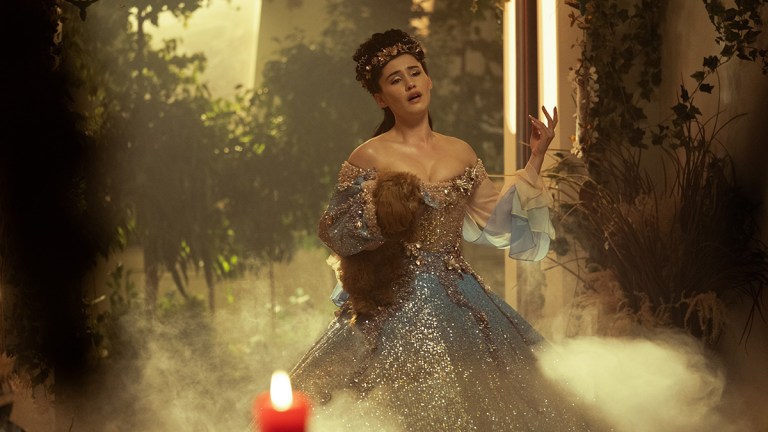How Star Trek: Strange New Worlds Hilariously Tweaks Classic Episodes
“The Elysium Kingdom” heard you liked it when aliens loved human books. Here’s how Star Trek: Strange New Worlds made this kind of story seem brand new.

This article contains Star Trek: Strange New Worlds spoilers.
Star Trek: Strange New Worlds Episode 8
Will space aliens judge us by our best works of narrative art? Likely not. If extraterrestrials exist, the truth is, they’ll probably know us by our most random works of fiction. Curating a golden record for aliens is a nice idea, but if you through telepathy and bedtime stories into the mix, the stories that represent humanity the most will be the ones we least expect. At least that’s the basic premise in Star Trek: Strange New Worlds Episode 8, “The Elysian Kingdom.”
Here’s how this Strange New Worlds episode draws inspiration from two classic — and hilarious — episodes from The Original Series with a brand new twist. Spoilers ahead.
At the start of “The Elysian Kingdom,” Dr. M’Benga (Babs Olusanmokun) finds his shipmates utterly transformed. Suddenly, the crew of the Enterprise has swapped their Starfleet attire for Renaissance Faire outfits. Ortegas is a swordmaster. La’an is a princess. Spock is a wizard. You get it. And, very early on, M’Benga is hip to the fact that all of the crew have been put into the roles of characters directly from a book he’s been reading as a bedtime story to his daughter Rukiya.
This notion — that aliens might replicate fiction IRL based simply on telepathy — has occurred throughout the Star Trek canon. And, of course, the idea of something you’re thinking about appearing in physical form to mess with you exists throughout all of science fiction, even Ghostbusters. But, arguably, three classic episodes of Star Trek: The Original Series perfected this notion, at least when it comes to aliens.
“Shore Leave”
In two episodes of The Original Series, we saw what happens when aliens make major decisions based on human books. In “Shore Leave,” telepathic scanners create bespoke robots directing from the imaginations of the crew, which is why in the opening moments of this episode, Bones sees Alice and the White Rabbit from Alice in Wonderland. It’s an iconic moment, but just like “The Elysian Kingdom,” this episode also had one of the crew — Yeoman Barrows — dressing up as a princess when a fairytale dress suddenly appeared out of thin air.
The essential difference between “Shore Leave” and “The Elysian Kingdom” is perhaps a tale of two princess dresses. In “Shore Leave” Barrows chooses to change out of her Starfleet uniform and don the princess dress and hat. But, in “The Elysian Kingdom,” La’an, simply becomes “Princess Thalia.” Ditto for Uhura’s “Queen Neve,” and the rest of the crew getting possessed by an alien consciousness, and then acting out characters — in costume — from the book M’Benga reads to Rukiya.
The idea of a spaceborne consciousness sending telepathic signals, is, of course, nothing new in Star Trek. Hemmer equates this notion to the idea of a “Boltzmann brain,” a philosophical notion of consciousness springing out from nothingness. But the alien mind living in the Jonisian Nebula in “The Elysian Kingdom” is not V’Ger from Star Trek: The Motion Picture. And that other difference is what makes this episode so delightful overall.
“A Piece of the Action”
In the hilarious TOS episode “A Piece of the Action,” the aliens who live on Sigma Iotia II base their entire culture on the teachings of one specific book; a history book called Chicago Mobs of the Twenties. While the Iotians basically look human and lack any telepathic powers, or the ability to instantly create costumes from nothing, they are, as Spock says, “highly imitative.” The idea that aliens would imitate scenes from human books to the point of permanent cosplay is not only hilarious, it also creates a perfect excuse for bizarre anachronisms.
“A Piece of the Action” shows what Star Trek can do with hyperbole in an episode unlike any other. The completism of “The Elysian Kingdom,” takes a similar approach. The alien doesn’t just make a few choices based on one book. It makes every choice based on this book (with a bit of help from Rukiya’s imagination).
The lonely space brain
Although The Original Series was all about boldly going and finding new aliens, often various planets were populated by figures and situations from Earth’s past; a new Roman Empire in “Bread and Circuses,” Abraham Lincoln in “The Savage Curtain,” and of course, everything about Trelane in “The Squire of Gothos.”
Oddly, off all of the TOS plotlines, Trelane is perhaps the one that is most similar to “The Elysian Kingdom,” albeit with a different ending. Again, you have some anachronistic dress-up, along with a lonely alien trying to communicate through cultural references from our own past. At the end of “The Squire of Gothos,” we also learn that Trelane doesn’t actually have a physical form, and is basically just a child-like alien space brain, looking for playmates.
The ending of “The Elysian Kingdom,” inverts the ending of “The Squire of Gothos.” Instead of leaving Trelane to be scolded by his space brain parents, Strange New Worlds has Rukiya leave to live with the consciousness in the Jonisian Nebula. In the final moments, we learn that Rukiya names the alien “Debra,” after her late mother. What begins as a hilarious romp, becomes a tender story of understanding. If the ending of “The Elysian Kingdom” was applied to TOS episodes like “Shore Leave” “A Piece of the Action,” or “The Squire of Gothos,” those episodes would suddenly be about one crew member staying behind to live with, and love robot rabbits, space mobsters, or lonely trickster gods. So, not only has Strange New Worlds honored those classic Trek tropes, it’s done so with a jolt of empathy, too.
